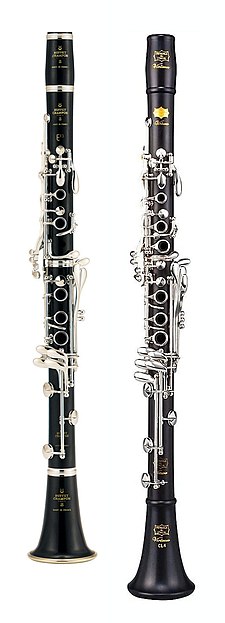
- Boehm Clarinet with 17 keys and 6 rings
- Full-Boehm clarinet, range to E flat, with 20 keys, 7 rings and left E-flat-lever
The Boehm system for the clarinet is a system of clarinet keywork, developed between 1839 and 1843 by Hyacinthe Klosé and Auguste Buffet jeune. The name is somewhat deceptive; the system was inspired by Theobald Boehm's system for the flute, but necessarily differs from it, since the clarinet overblows at the twelfth rather than the flute's octave. Boehm himself was not involved in its development.
Klosé and Buffet took the standard soprano clarinet, adapted the ring and axle keywork system to correct serious intonation issues on both the upper and lower joints of the instrument, and added duplicate keys for the left and right little fingers, simplifying several difficult articulations throughout the range of the instrument.
The Boehm clarinet was initially most successful in France—it was nearly the only type of clarinet used in France by the end of the 1870s—but it started replacing the Albert system clarinet and its descendants in Belgium, Italy, and America in the 1870s and—following the example of Manuel Gómez, a prominent clarinettist in London who used the Boehm system and the Full Boehm system clarinet—in England in the 1890s.[1][2] By the early twentieth century, virtually all clarinets used by performers outside of Germany, Austria, and Russia were of the Boehm system or one of its derivatives. The only alteration to Klosé and Buffet's clarinet that has wide currency is the Full Boehm system clarinet which was introduced by Buffet in the 1870s.
- ^ Rendall, F. Geoffrey (1971). The Clarinet. London: Ernest Benn Limited. p. 99. ISBN 0-510-36701-1. (Third Edition)
- ^ Baines, Anthony (1991). Woodwind Instruments and Their History. New York: Dover. pp. 320–323. ISBN 0-486-26885-3. (republication of third edition, 1967, as reprinted with corrections, 1977)